
Mound is a city in western Hennepin County, Minnesota, United States. The population was 9,052 at the 2010 census. Mound was the birthplace of the Tonka truck that is named after Lake Minnetonka, which the eastern part of town sits on. Mound is 22 miles (35 km) west of Minneapolis, the county seat.

Wayzata is a city in Hennepin County, Minnesota, United States. The population was 4,434 at the 2020 census. The city is about 12 miles west of Minneapolis and is situated on the northern shore of Lake Minnetonka, the ninth largest lake in the state.

Lake Minnetonka is a lake located about 16 miles (26 km) west-southwest of Minneapolis, Minnesota. Lake Minnetonka has about 23 named bays and areas. The lake lies within Hennepin and Carver counties and is surrounded by 13 incorporated municipalities. At 14,528 acres (5,879 ha), it is Minnesota's ninth largest lake.

Minnehaha is a steam-powered excursion vessel on Lake Minnetonka in the U.S. state of Minnesota. The vessel was originally in service between 1906 and 1926. After being scuttled in 1926, Minnehaha was raised from the bottom of Lake Minnetonka in 1980, restored, and returned to active service in 1996. The vessel operated uninterrupted on Lake Minnetonka until 2019. It is currently stored in a maintenance facility in the town of Excelsior.
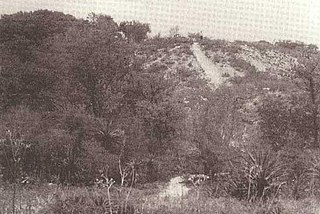
Mound Key Archaeological State Park is a Florida State Park, located in Estero Bay, near the mouth of the Estero River. One hundred and thirteen of the island's one hundred and twenty-five acres are managed by the park system. It is a complex of mounds and accumulated shell, fish bone, and pottery middens that rises more than 30 feet above the waters of the bay.
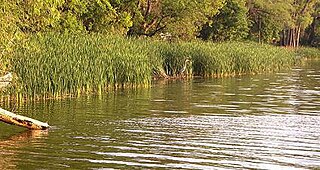
Lake Langdon in Mound, Minnesota, has an area of 144 acres (0.6 km2). Minnehaha Creek Watershed District (MCWD) charts show its maximum depth of 38 feet (12 m), though it would be classified as a shallow lake with a mean depth of 8.3 feet (2.5 m). It is named for R. V. Langdon, the first township clerk. It is located west of Commerce Boulevard and south of Lynwood Boulevard. Boats on the lake cannot navigate to the nearby Lake Minnetonka, though it overflows into Lost Lake, part of the Big Lake, through Langdon Bay Creek. It also serves as an outlet for Saunders Lake, to its west. The lake has a watershed area to surface area ratio of 6.5:1, meaning that it drains an area about 6½ times its size.

The Charles H. Burwell House is a historic house museum in Minnetonka, Minnesota, United States, built in 1883. Charles H. Burwell (1838–1917) was the secretary and manager of the Minnetonka Mills Company, the first mill west of Minneapolis, around which grew the first permanent Euro-American settlement in Hennepin County west of Minneapolis. This property on Minnehaha Creek, including the house and two outbuildings, is listed on the National Register of Historic Places for its Carpenter Gothic/Stick style architecture and association with Minnetonka's early milling history.
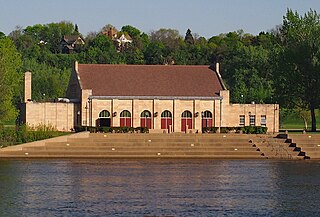
The Harriet Island Pavilion, also known as the Clarence W. Wigington Pavilion, is a park pavilion on Harriet Island just across the Mississippi River from downtown Saint Paul, Minnesota, United States. It was designed by Clarence W. Wigington, the nation's first black municipal architect, and renamed for Wigington after a 2000 restoration. Harriet island was named for Harriet Bishop, a Baptist school teacher from Vermont. She arrived in Saint Paul in 1847, was involved in the temperance movement, and opened the first school in the frontier city, teaching children of diverse ethnic, racial, and religious backgrounds.

Harry Wild Jones was an American architect based in Minneapolis who designed throughout the country and the world. Born two years before the start of the American Civil War, Jones, a twelfth-generation New Englander, took his place on the American architectural stage in the late 19th century. His life spanned seventy-six years, during a period of U.S. history that matched his exuberant, spirited personality. Known as an architect adept at any design technique, Jones is credited with introducing Shingle Style architecture to Minneapolis. He created an impressive portfolio from neoclassic to eclectic, reflecting his unique brand of versatility and creativity.
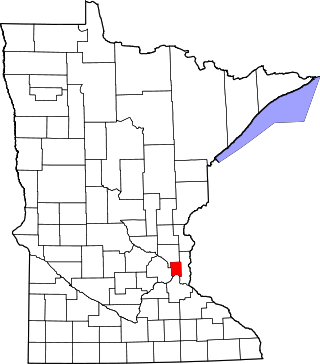
This is a complete list of National Register of Historic Places listings in Ramsey County, Minnesota. It is intended to be a complete list of the properties and districts on the National Register of Historic Places in Ramsey County, Minnesota, United States. The locations of National Register properties and districts for which the latitude and longitude coordinates are included below, may be seen in an online map.

The Minnesota Boat Club Boathouse on Raspberry Island is a historic structure in Saint Paul, Minnesota, United States. It is the home of the Minnesota Boat Club, a rowing club founded in 1870, that is Minnesota's oldest athletic organization. In 1885, a wooden structure was built on Raspberry Island to house the Minnesota Boat Club. The club constructed a new boathouse in 1910, which was designed by George H. Carsley in the style of Mission Revival architecture. The boathouse building was listed on the National Register of Historic Places in 1982.

The Charles P. Noyes Cottage was a summer home of Saint Paul pharmacist, Charles P. Noyes, who came to St. Paul in 1868. The cottage is listed on the National Register of Historic Places.

The Loren L. Chadwick Cottages are two cottages in the Linden Hills neighborhood of in Minneapolis, Minnesota, United States, situated roughly south of Bde Maka Ska and northwest of Lake Harriet. This area of Minneapolis was platted in 1882-83 as "Cottage City" by a local real estate developer, Louis F. Menage. He platted small 25 feet (7.6 m)-wide lots, as opposed to the normal lot width of 40 feet (12 m), in an effort to attract people who wanted to build summer lake cottages.
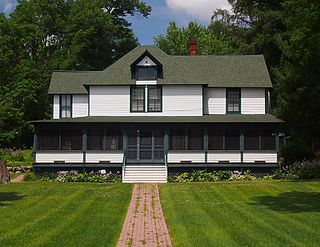
The Thompson Summer House is a house in Minnetonka Beach, Minnesota, United States, listed on the National Register of Historic Places. It is located on Hennepin County Road 15, across from Lafayette Bay on Lake Minnetonka.

Excelsior Public School is a former school building in Excelsior, Minnesota, United States, listed on the National Register of Historic Places. The school was built in the Georgian Revival style between 1899 and 1901 to serve Excelsior during a time of growth in the community. Before this building was built, two other school buildings were located on the site. The first was moved to 321-323 Third Street, and the second was destroyed by fire.
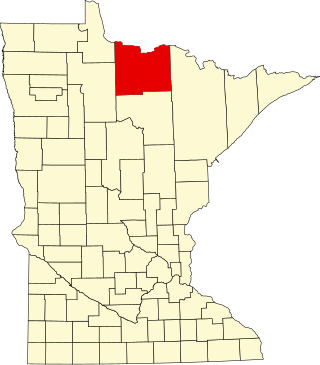
This is a list of the National Register of Historic Places listings in Koochiching County, Minnesota. It is intended to be a complete list of the properties and districts on the National Register of Historic Places in Koochiching County, Minnesota, United States. The locations of National Register properties and districts for which the latitude and longitude coordinates are included below, may be seen in an online map.
This is a list of the National Register of Historic Places listings in Voyageurs National Park.
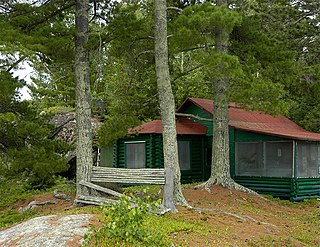
The Jun Fujita Cabin is a historic summer cabin in the U.S. state of Minnesota, owned by photographer and poet Jun Fujita (1888–1963). He built it in 1928 on an island in Rainy Lake, an area of the Boundary Waters that later became Voyageurs National Park. The cabin was listed on the National Register of Historic Places in 1996 for its local significance in the themes of art, Asian ethnic heritage, and entertainment/recreation. It was nominated for its association with Fujita, one of the first Japanese Americans to gain prominence in the American Midwest, and as a rare surviving example of the early recreational development of the Boundary Waters.
The Schilling Archeological District is a prehistoric Native American archaeological site on private property on Lower Grey Cloud Island in Cottage Grove, Minnesota, United States. It consists of a habitation site and mound group with artifacts that date from the Early Woodland Period to the Late Prehistoric Period. It was listed on the National Register of Historic Places in 1978 for having state-level significance in the theme of archaeology. It was nominated for its rare Early Woodland component, Middle Mississippian cultural influences, and potential to show climatic adaptations over time.

Finstad's Auto Marine Shop is a former boat repair shop in Ranier, Minnesota, United States. It was built in 1911 on the south shore of Rainy Lake, and preserves its original belt-driven machinery. George Finstad acquired the shop in 1924 and continued to provide maintenance and storage services for fishermen, residents, and vacationers there for just over fifty years. The building was listed on the National Register of Historic Places in 1983 for its local significance in the themes of entertainment/recreation and transportation. It was nominated for its association with the early tourists and summer residents of the Rainy Lake region, a significant factor in Koochiching County's early-20th-century development.























